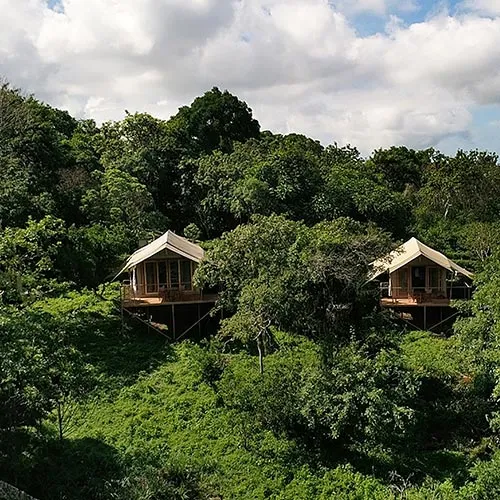Santa Fe: At a glance
- Uninhabited by humans
- 24 squared km / 9 squared miles
- Elevation: 250m above sea level.
- South-east of Santa Cruz
- From Galapagos Safari Camp, it can be accessed by boat (1.5 hours, each way)
- Named after Admiral Samuel Barrington
- One of oldest islands on archipelago – approximately 4 million years.
Santa Fe Safari Highlights
- Sea Lions
- Santa Fe Land Iguana
- Galapagos Hawk
- Palo Santo tree (Bursera graveolens)
- Giant prickly pear cactus (Opuntia echoes)
- Snorkeling
Why should you include Santa Fe on your Galapagos Safari Tour?
1. Sea Lions
Upon arriving at Santa Fe, you will be transported to the island from the main boat by a small dingy. The beach landing can be a little wet (bring appropriate shoes), and noisy! The sandy cove is usually inhabited by a large colony of sea lions. It’s not uncommon to see a number of females nursing their pups and to see the yearlings playing among themselves much like a litter of puppy dogs.
The tour begins by observing the sea lions on the beach before following the main trail inland.
2) The Santa Fe Land Iguana
There are three species of land iguanas in the Galapagos Islands. One them – The Conolophus pallidus – is not only endemic to the Galapagos, but to the island of Santa Fe itself. In Latin pallidus means ‘pale’ and refers to its creamy-yellow colour. The land iguana’s skin color actually seems to blend in perfectly with the entire island’s general off-white hue, dominated by Palo Santo trees.
The population of Santa Fe Land Iguanas reaches approximately 7,500 individuals. They feed mostly on cacti, and are occasionally known to eat small insects such as beetles and centipedes.
Santa Fe land iguanas are very terrestrial and during the breeding season, the males defend territories as large as 20 squared meters by wrestling aggressively in the bushes, sometimes unrelentingly for hours upon end. One adult male may mate with up to seven females in one season.
By October and November the females are ready to lay their eggs and dig holes in the sand in which to place the eggs. They can lay between two and twenty eggs which take around four months to hatch.
The Santa Fe iguanas can be seen all year round and your chance of spotting them on your safari are usually very good. As you walk along the dusty trail, you’ll begin to spot them on every side.
3) The Galapagos Hawk
Santa Fe is also home to the Galapagos Hawk (Buteo galapagoensis). Like the iguanas, the Galapagos Hawk is also an endemic species, and with only 150 mating pairs across the archipelago, spotting one on Santa Fe will certainly be a highlight of your Galapagos Safari.
4) Santa Fe’s Prickly Pear Cacti
The land iguanas feed off of what are officially the largest Opuntia cacti in the entire archipelago. On Santa Fe Opuntia trees (also known as prickly-pear cacti) can be over twelve-meters tall. The species is endemic to the archipelago and the trees are characterized by thick red trunks and fleshy, round cacti pads, each the size of a tennis racket.
5) Palo Santo trees
In addition to the Prickly Pear Cacti, the island is also covered with palo santo trees, an arid-zone, deciduous species of tree that sheds its leaves in the cool season (June to December), exposing silvery bark covered in lichen and then spouts green leaves again during the hot, rainy season (January to June).
6) Snorkeling
Our Santa Fe safari also includes a snorkel in the waters of the bay. This presents an excellent opportunity to swim with the playful sea lions, as well as a chance to see some of the other marine wonders of the Galapagos, including rays, turtles and possibly the odd shark.
Our Santa Fe Safari is a full-day trip and includes lunch on the boat.
Galapagos Islands to Visit
To learn more about the other islands we visit, see our guides below:
Plan your Galapagos Vacation!
For more information on our tailor-made Galapagos Tours, see Our Safaris.
Disclaimer: As with any wildlife holiday experience, we cannot guarantee that you will see each of the species mentioned in this article. Instead, please view this information as a guide, based on the experience of our expert naturalists and guests at Galapagos Safari Camp.
